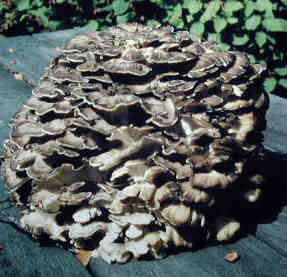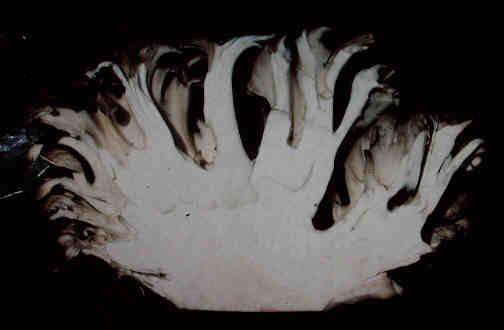| 09-22-03
I am often asked questions about squirrels, squirrel
hunting, skinning and
cooking,
but I think the most valid inquiry on Mr. Bushytail involves the wild taste
of the meat, which, I think, is mostly imagined.
For many years members of my family in Southern Indiana literally lived
on squirrels from opening to close of the summer season on squirrels.
We didn't notice that squirrel meat was a bit "gamey," perhaps because
when fried or in a pot of dumplings the residual hot biscuits, fried potatoes
(with onion, of course) boiled beans, corn-on-the-cob, sliced garden tomatoes,
and, of course those rolled-out
dumplings would thwart a wild taste, if it were present.
Still, now and again some Hoosier outdoors person sidles up to me and
asks: "How do you eliminate that "gamey" taste in squirrels?"
Although we did not bother with them when I was a kid, I occasionally
hunted with--or was around--numerous Hoosier outdoors folks who did.
The "thing" (if we may bestow such a moniker on it) that made squirrel
meat taste a bit gamey was/is the so-called glands that are found at four
points on the body of a squirrel, in or very close to the meat of the four
legs.
It may be that the glands occur in other parts of a squirrel. But if
this is true none of my outdoor contacts, who were woodsy to the bone,
ever mentioned them.
The glands of a squirrel take two forms. One is a dime-sized strip of
gray matter (a sort-of cross between gristle and fat) that will be found
between the rib cage and front legs. It is easily spotted when a squirrel
is cut into pieces for cooking. It can be removed just as easily by shaving
it off with the blade of a sharp knife.
The other gland occurs in the form of a small, gray nodule of gristle
about twice the thickness of a grain of rice. It occurs on the back side
of the back legs at the point where the leg bends. A small cut with a sharp
knife at the back side of the leg joint (the meat is creased slightly crosswise,
and this is where the cut should be made) will bring this one into good
view. It can be lifted out by pressing it against the knife blade with
the thumb.
I think I first heard about the glands of squirrels as a small boy.
I had accompanied my father to sell some fur to the fur buyer who did business
on a street corner at Crothersville during the trapping season.
The fur buyer, a bushy-red-haired old geezer with beard to match, knew
our family bagged a lot of squirrels. He was trying to get my father to
save squirrel glands and dry them for him. He seemed to think there was
a ready market for dried glands, pointing out that fox trappers used them
as scent. This, incidentally, was long before Indiana had its first coyote,
but glands probably would lure the little dogs as well.
My dad removed front leg glands when skinning squirrels and I have done
likewise. But only because they are so unlike good squirrel meat and so
obvious.
ABOUT HEN-OF-THE-WOODS
I recently was contacted by someone about my methods of preserving hen-of-the-woods
(Grifola frondosa), alias sheep's head.
Whether it was an e-mail, a regular mail, or whatever, my organizational
talents (or lack thereof) lost all traces of the inquiry. Thus, my only
recourse rests with this column and my web page (www.bayoubill.com).
It was a most appropriate time for such a query. The hen, and many other
fall mushrooms, could be popping up any time now that the heat of summer
is gone and fall rains are coming.
The hen, which usually is found near white oak trees, somewhat resembles
the cushion chrysanthemum (popular fall flower), grows from a root of the
host tree. It often is very close to the trunk of the tree, even attached.
I preserve the hen by slicing the main body, which is somewhat like
the breast of a turkey, into inch-wide strips about 1/8 (one-eighth) inch
thick.
I preserve it in two ways. I dry
some in my little food dryer, and freeze some on a cookie sheet. When
the strips are dried or frozen, I cork them up tight in clean glass jars.
I store the dried strips in a cool, dark place. The frozen strips are kept
frozen, checked often to avoid freezer burn.
Frozen strips also are stored in plastic freezer bags and wrapped tightly
in a few thicknesses of newspaper to avoid freezer burn.
I use dried strips in dishes that are moist . . . like gravy soups,
stews, or even bird stuffing. They also may be rehydrated and sautéed
in olive oil, butter, or some other cooking agent. The frozen strips may
be used in the same ways, but I usually sauté them to serve with
eggs and bacon.
Fronds of the hen are preserved and used in the same ways. Larger fronds
are sliced small enough to make them workable.

|

|
| This
four-pound hen-of-the-woods mushroom is easy to spot in the woods. |
This
cut-away shot of hen-of-the-woods mushroom illustrates the large turkey-breast-like
body of the hen-of-the-woods and the fronds, which also are tasty in many
dishes. |
|

